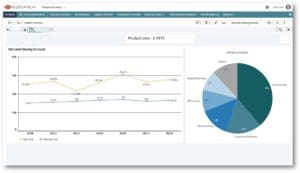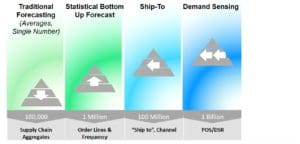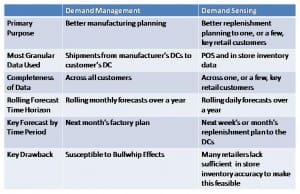Machine learning has become hot this year and suppliers are investing research and development into using machine learning in the supply chain. But in a conversation with Michael Farlekas and John Lash – the CEO and VP of Product Marketing at E2open respectively – I was reminded of the fact that machine learning in the supply chain is not a new technology. Last year E2open acquired Terra Technology. Terra has been using machine learning to power their demand management and demand sensing applications since 2004. Their customers include Procter & Gamble, Unilever, AkzoNobel, and several other global, multinational companies.
For machine learning to work well, it needs to be a big data application. In this case in addition to doing forecasting based on historical sales, companies leverage other data sets such as their retail customer’s point of sale, recent shipments of products from their warehouses to their stores, the retailer’s orders, syndicated data, and store inventory. Many of these data sets are accessed daily, or even several times a day, so the dynamic nature of demand is captured to a much higher degree than traditional forecasting techniques.
E2open also acquired Orchestro last year. This is a demand signal repository solution which harmonizes retail Point of Sale (POS), syndicated, internal ERP, and 3rd party data into a common view of demand. In other words, the Orchestro solution makes it much easier to access demand sensing retail data sets.
Machine Learning for Demand Management
Machine learning for demand management works this way. The engine is making many forecasts simultaneously in different planning horizons. So, there can be a forecast for demand for liquid detergent in a 100-ounce container to the Walmart store in Tuscaloosa tomorrow, one week out, and one month out. There can also be a forecast for how much of that detergent will be needed at the distribution center in Cullman, Alabama tomorrow, one week, and one month from now. Other forecasts are being done for other big retail customers and channels.

Machine Learning is Used for Demand Sensing in the E2open Solution
For the forecast of what is needed in the Tuscaloosa store tomorrow, it may be that the data source with the highest influence factor is point of sale and the algorithm weights it accordingly. For a forecast of how much of that detergent will be needed in the Cullman warehouse in a month, a different algorithm is used that weights the data sets such that the statistical forecast is most important, recent shipments the second most important; customer orders third, and so forth.
Then every day, all of these forecasts at all locations and all time horizons are done again.
When this was first explained to me a few years ago, my reaction was “even if you can make all these forecasts, why would you? How could you operationalize this?”
The answer is that different forecasts are used in different time horizons by different groups in the company. So, if a factory has a frozen two-week production schedule, and the new schedule starts on October 16th, the factory planner will use the aggregated daily forecasts of the actual 14 days from October 16th through the 30th to create the forecast for demand over this specific time period and based on the projected inventory, determine what products they need to produce for the next two weeks. All other forecasts are ignored until the next production run needs to begin, when they once again use the most recent forecast pertinent to their needs.
But other departments use different forecasts in different time buckets. Thus, on that same Day 0 – October 16th – the transportation department might find it very helpful to know projected shipments to all the distribution centers on October 19th to create their private fleet plan for the 19th. In this case, there is a deployment lead time of 3 days so the daily forecasts between Oct 16th and the 19th are aggregated to determine how much inventory will be at the DCs on Oct 19th and how much will need to be shipped on the 19th to maintain service commitments.
It should also be pointed out, that the machine learning engine does not rest on its laurels. It continues to monitor the accuracy of all forecasts, continues to reweight which data sets are used at all locations in all time horizons. Mr. Farlekas says that E2open has strong evidence that the more humans are allowed to change forecasts, the worse those forecasts become. In short, this is a black box solution.
This is, perhaps, why I had a hard time remembering that the E2open solution was based on machine learning. Machine learning has only become sexy in the last year or two, before that the folks I talked to at the old Terra Technology seemed a bit reluctant to explain exactly how they did what they did, because “black box” solutions were definitely not sexy.
The same dynamic is playing out in the supply planning area for the process manufacturing industry. A leading supplier recently explained to me how they use machine learning to solve a particular planning problem, but then asked me to keep that information confidential because solutions not based on “first principles” in that industry are considered inferior. They have been using this machine learning solution since 2002, but you would never know that from reading their website.
One final point, the E2open solution is a productized solution. Mr. Farlekas said that their solution is “commercial grade, our customers don’t need data scientists and the solution does not require training.”
However, as we begin to look at adding unstructured data sets to our demand models – like social media sentiment – it is a tough problem to analyze that data and transform it into ‘scored’ data that can be analyzed by the demand planning engine. I talked to Jeff Bodenstab, the VP of Marketing at the ToolsGroup, on this topic. They have just released a product called Social Sensing to solve this problem, but he admits it is early stage. They are just going through their first implementations right now. This data set will be most useful for new product introductions and promotions forecasting.
In conclusion, machine learning is a hot new topic for supply chain executives. But it’s not new.


















